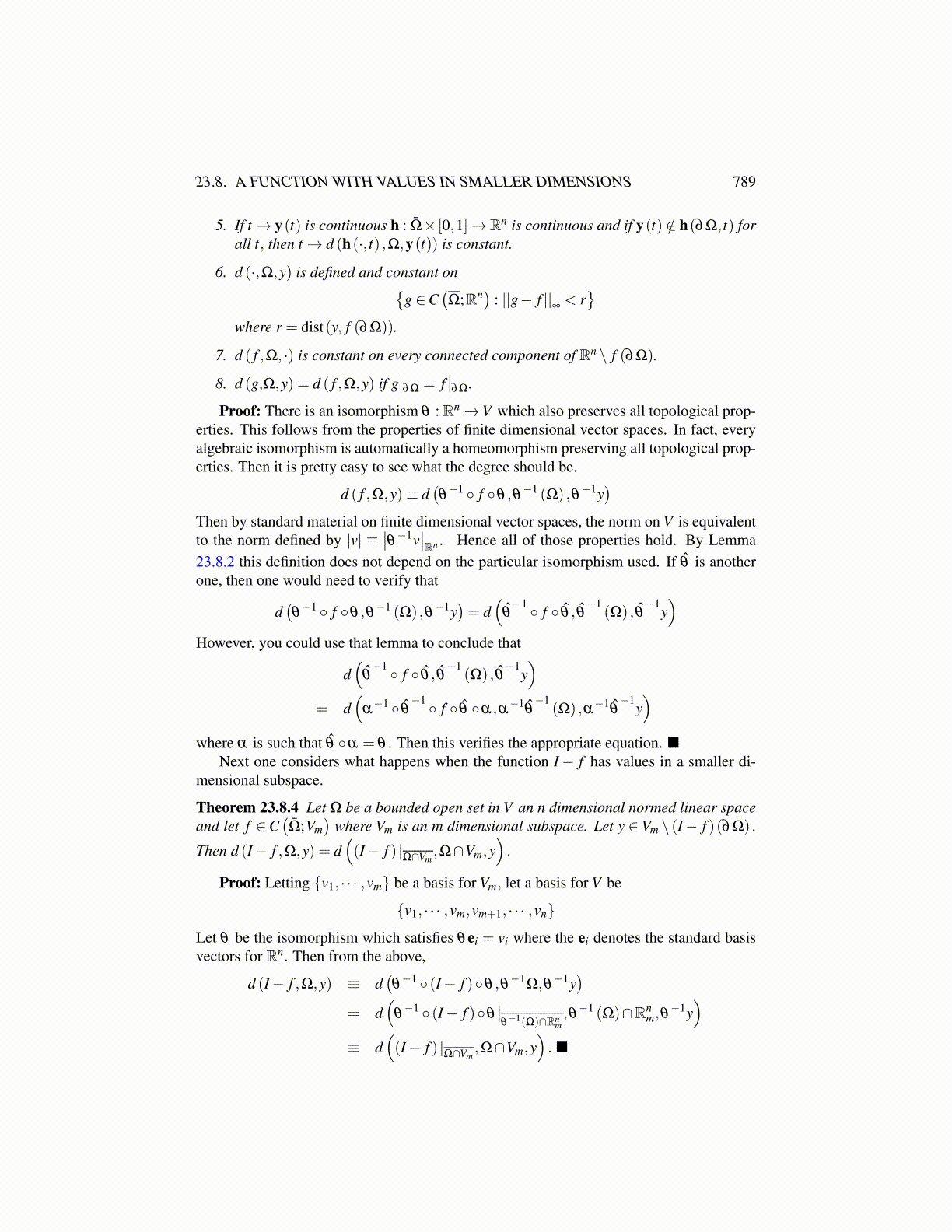
23.8. A FUNCTION WITH VALUES IN SMALLER DIMENSIONS 789
3. If y/∈ f(Ω\Ω1
)and Ω1 is an open subset of Ω, then
d ( f ,Ω,y) = d ( f ,Ω1,y) .
4. For y ∈ Rn \ f (∂Ω) , if d ( f ,Ω,y) ̸= 0 then f−1 (y)∩Ω ̸= /0.
5. If t→ y(t) is continuous h : Ω̄× [0,1]→Rn is continuous and if y(t) /∈ h(∂Ω, t) forall t, then t→ d (h(·, t) ,Ω,y(t)) is constant.
6. d (·,Ω,y) is defined and constant on{g ∈C
(Ω;Rn) : ||g− f ||
∞< r}
where r = dist(y, f (∂Ω)).
7. d ( f ,Ω, ·) is constant on every connected component of Rn \ f (∂Ω).
8. d (g,Ω,y) = d ( f ,Ω,y) if g|∂Ω = f |∂Ω.
Proof: There is an isomorphism θ :Rn→V which also preserves all topological prop-erties. This follows from the properties of finite dimensional vector spaces. In fact, everyalgebraic isomorphism is automatically a homeomorphism preserving all topological prop-erties. Then it is pretty easy to see what the degree should be.
d ( f ,Ω,y)≡ d(θ−1 ◦ f ◦θ ,θ−1 (Ω) ,θ−1y
)Then by standard material on finite dimensional vector spaces, the norm on V is equivalentto the norm defined by |v| ≡
∣∣θ−1v∣∣Rn . Hence all of those properties hold. By Lemma
23.8.2 this definition does not depend on the particular isomorphism used. If θ̂ is anotherone, then one would need to verify that
d(θ−1 ◦ f ◦θ ,θ−1 (Ω) ,θ−1y
)= d
(θ̂−1 ◦ f ◦ θ̂ , θ̂
−1(Ω) , θ̂
−1y)
However, you could use that lemma to conclude that
d(
θ̂−1 ◦ f ◦ θ̂ , θ̂
−1(Ω) , θ̂
−1y)
= d(
α−1 ◦ θ̂
−1 ◦ f ◦ θ̂ ◦α,α−1θ̂−1
(Ω) ,α−1θ̂−1
y)
where α is such that θ̂ ◦α = θ . Then this verifies the appropriate equation.Next one considers what happens when the function I− f has values in a smaller di-
mensional subspace.
Theorem 23.8.4 Let Ω be a bounded open set in V an n dimensional normed linear spaceand let f ∈C
(Ω̄;Vm
)where Vm is an m dimensional subspace. Let y ∈ Vm \ (I− f )(∂Ω) .
Then d (I− f ,Ω,y) = d((I− f ) |
Ω∩Vm,Ω∩Vm,y
).